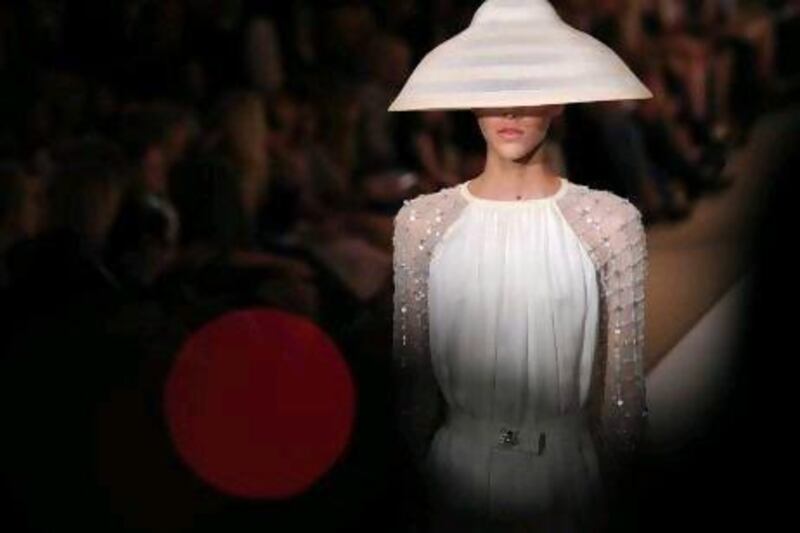London is, and always has been, about individualism. Where trends in New York are often easy to categorise, designers in Britain’s capital, like the street-fashion pioneers who inspire them, search for innovation and uniqueness. In the past, this has taken them off into worlds so uncommercial it’s impossible to find the buyers necessary to keep their businesses going. However, the British Fashion Council’s funding schemes and involvement in education mean that right now, London is basking in a new credibility, producing fashion that is explosive yet largely wearable. And beneath the flights of fancy, brilliant sets and wacky styling, there are plenty of trend threads to look out for this season.
Apricot
This soft, peachy shade of orange is the romantic sister to New York's coral obsession. Emma Hill at Mulberry used apricot from daywear to evening on prints and lace, creating an almost sepia, retro effect. Richard Nicoll mixed it up with mint in neat jersey sportswear. Even some gentle apricot, pinky-orange and peach frocks were found among Issa London's hot tropical prints.
Lace
It's been an obsession for a while, but designers continue to find new ways to deal with lace, including as outerwear. Christopher Raeburn encased it in plastic to make raincoats, Christopher Bailey at Burberry bonded leather to metallic foil and laser-cut it to make a lacy trench, Paul Smith panelled it into his silk dresses, Temperley used an oversized abstract lace overlay (rather like Calvin Klein's version last week), and Simone Rocha picked a giant floral lace to turn into neon dresses. And that's before you even start on broderie anglaise.
Rave culture
Henry Holland's show invitation was an iPhone case in a classic 1990s green and pink psychedelic tie-dye pattern, and his House of Holland collection was just as tied to the era, with tie-dye frocks, grungy shapes, heavy boots and a classic soundtrack including Deee-Lite's Groove Is in the Heart and Urban Cookie Collective's I've Got the Key. Louise Gray, meanwhile, went back to late 1980s, with a collection full of neon, graffiti, tribal make-up and music even more old-skool than Holland's.
Stripes
A look common to both New York and London, stripes came as prints, panels, knits and devoré fabrics, with styles ranging from romantic to sporty. Possibly the most luxe version was from Temperley, in which organza was panelled with satin horizontal stripes on dirndl skirts, while PPQ had nautical stripes and Jonathan Saunders used metallic stripes on jackets.
Shocking pink
It genuinely was shocking when the king of pale and interesting, John Rocha, chose to start and end his show with vibrant pink bubbles of dresses. The similarly minimalist Osman also added bolts of fuchsia, together with electric blue and yellow.
From our London Fashion Week 2012 blog
• Day one: fragile flavours from Willow and Bora Aksu
• Day two: a bunch of raving hippies but John Rocha goes against the grain
• Day three: feeling blue at Ford, Schwab, Temperley, Smith
• Day four: old-school revivals at Louise Gray, Burberry, Richard Nicoll, Osman and a family affair at Smythson
• Day five: gecko fabulous at Mulberry, disco divas at Roksanda Ilincic, neon novelty at Simone Rocha
1970s
From bishop sleeves to slender-fit trenches, the sassy style of the 1970s woman was everywhere, but the two designers who most obviously - and most differently - cited the decade for their collections were Roksanda Ilincic, with flares and paper boy caps a-go-go, and Emma Hill at Mulberry, whose maxi dresses and lovely prints were more Ossie Clark romantic than New York disco diva.
Metallic
It's a trend that rarely goes away now, partly thanks to ever-improving fabric and leather technology. Mulberry, Pringle of Scotland, Jonathan Saunders and House of Holland all played around with Lurex knit and shiny leather. The most unforgettable example, though, came at Burberry, where silk and metallic thread was woven together for a plissé effect on dresses and jackets, and foiled leather was used on bags, shoes and, spectacularly, on the final series of metallic leather trenches, in a rainbow of colours.
Hoods
In a rare display of pragmatism, large hoods appeared to be a big thing for London designers, who were perhaps remembering this summer's downpours. They looked best on starchy duffels, as with Kinder Aggugini's prettily printed nautical version and Richard Nicoll's edgier sports-styled one.
Grey marl jersey
The preppy, sport-influenced look has been popular in New York and London, but that perennial athletics fabric grey marl jersey had a particular boost from Richard Nicoll and Roksanda Ilincic. Nicoll panelled it into his neat jersey dresses, which looked deceptively simple but on closer inspection were subject to fiendish pattern-construction. Ilincic went for a more relaxed approach, throwing it into her 1970s mix as belted dresses that were wrangled and twisted into shape, with turned-up sleeves, dance-studio-style.
Floral
London isn't London without some vibrant, quirky reference to blooms and blossoms, at least for spring/summer seasons. For 2013 it came in a multitude of forms, from daisy-shaped jacket studs and embossed leather at Mulberry and printed, sequinned and appliquéd roses at Holly Fulton to tropical blooms on Issa's long dresses (with orchids in the models' hair), densely ruffled rosette shapes in bright silk at John Rocha and a modern rose print in shades of grey at Paul Smith, panelled with blocks of richly coloured silk.





